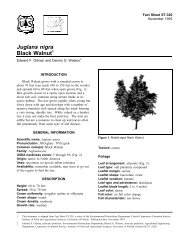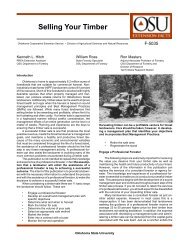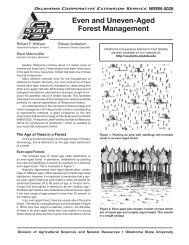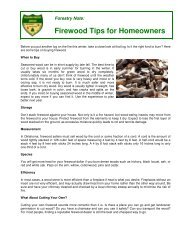Best Management Practices for Forest Road Construction and ...
Best Management Practices for Forest Road Construction and ...
Best Management Practices for Forest Road Construction and ...
- No tags were found...
You also want an ePaper? Increase the reach of your titles
YUMPU automatically turns print PDFs into web optimized ePapers that Google loves.
Culvert InstallationPlug the ditch immediately downhill of the culvert inlet to directall water into the culvert (Figure 3).Extend the culvert outlet beyond the fill slope. Install rocks orslash at the outlet to prevent erosion by concentrated flow.• Angle culverts 30 degrees downslope.• Make culvert gradients at least two percent greater than theditch gradient.• Locate culverts so they do not outlet directly into streams.Drainage DipsDrainage dips provide cross drainage <strong>and</strong> drainage of water thatcollects on road surfaces. Dips can be used instead of crossdrainculverts, usually at lower cost. They are especially wellsuited <strong>for</strong> temporary roads. Dips must be deep enough to provideadequate drainage, but wide enough to allow the safe passageof trucks <strong>and</strong> equipment. The type of dip selected depends onexpected use <strong>and</strong> type of road. The spacing of drainage dipsis determined by slope steepness <strong>and</strong> local conditions (Table3 on page 15). Place rock or slash below the outlet to preventerosion.Rolling dips (Figure 4) are best <strong>for</strong> spur <strong>and</strong> temporary roadsthat have little traffic at low speeds. Rolling dips resemble“stretched out” water bars. The dip is excavated out of theexisting road grade.Broad-based dips (Figure 5) are best <strong>for</strong> roads with high trafficvolumes <strong>and</strong> speeds, such as permanent main haul roads. Theroad grade between dips is adjusted so there is a constantgrade from the crest of the berm of one dip to the bottom ofthe next dip downslope.11
















